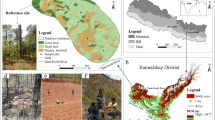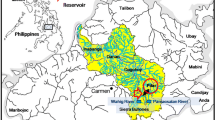Abstract
The formulation of watershed management strategies to protect water resources threatened by soil erosion and sedimentation requires a thorough understanding of sediment sources and factors that drive soil movement in the watershed. This paper describes a study of medium-term water-driven soil erosion rates in a mountainous watershed of the Shihmen Reservoir in Taiwan. A total of 60 sampling sites were selected along a hillslope. At each sampling site, the inventory 137Cs activity was determined and then calculated with the diffusion and migration model to derive soil erosion rates. The rates are one to two orders of magnitude lower than estimates using the Universal Soil Loss Equation, a soil erosion model often used in Taiwan. Results of multiple regression analysis indicate that the spatial variability of soil erosion rates is associated with the relative position of a sampling site to the nearest ridge and soil bulk densities (r 2 = 0.33, p < 0.01). Finally, the patterns of soil redistribution rates on the hillslope follow the 137Cs hillslope model as soil erosion increases in the downslope direction. No deposition site is found at footslope because soil deposition is swept away by regular flooding along the stream channel. This study is an important first step in using 137Cs as a tracer of soil redistribution in mountainous watersheds of Taiwan.





Similar content being viewed by others
References
Basher LR (2000) Surface erosion assessment using 137Cs: examples from New Zealand. Acta Geol Hispanica 35(3–4):219–228
Belyaev VR, Wallbrink PJ, Golosov VN, Murray AS, Sidorchuk AY (2005) A comparison of methods for evaluating soil redistribution in the severely eroded Stavropol region, southern European Russia. Geomorphology 65(3–4):173–193. doi:10.1016/j.geomorph.2004.09.001
Catani F, Segoni S, Falorni G (2010) An empirical geomorphology-based approach to the spatial prediction of soil thickness at catchment scale. Water Resour Res 46:W05508. doi:10.1029/2008WR007450
Chang KT, Chiang SH (2009) An integrated model for predicting rainfall-induced landslides. Geomorphology 105:366–373
Chen SC, Wu CY, Wu YL, Wang SH (2009) Taiwan universal soil loss equation (TUSLE) based on revised factors and GIS layers—an example from the Shihmen reservoir watershed. J Chin Soil Water Conserv 40(2):185–197 (in Chinese)
Chiang SH, Chang KT (2009) Application of radar data to modeling rainfall-induced landslides. Geomorphology 103:299–309
Chiu CY, Lai SY, Lin YM, Chiang HC (1999) Distribution of the radionuclide Cs-137 in the soils of a wet mountainous forest in Taiwan. Appl Radiat Isot 50(6):1097–1103
Chiu YJ, Borghuis AM, Lee HY, Chang KT, Chao JH (2007) Estimation of soil erosion in a reservoir watershed using 137Cs fallout radionuclide. Int J Sediment Res 4:304–317
Dadson SJ, Hovius N, Chen H, Dade WB, Lin JC, Hsu ML, Lin CW, Horng MJ, Chen TC, Milliman J, Stark CP (2004) Earthquake-triggered increase in sediment delivery from an active mountain belt. Geology 32(8):733–736
Fukuyama T, Takenaka C, Onda Y (2005) 137Cs loss via soil erosion from a mountainous headwater catchment in central Japan. Sci Total Environ 350:238–247
Fukuyama T, Onda Y, Takenaka C, Walling DE (2008) Investigating erosion rates within a Japanese cypress plantation using Cs-137 and Pb-210 ex measurements. J Geophys Res Earth 113:F02007
Garcia-Oliva F, Lugo RM, Maass JM (1995) Long-term net soil erosion as determined by 137Cs redistribution in an undisturbed and perturbed tropical deciduous forest ecosystem. Geoderma 68:135–147
Guthrie RH, Evans SG (2004) Analysis of landslide frequencies and characteristics in a natural system, Coastal British Columbia. Earth Surf Proc Land 29:1321–1339
He Q, Walling DE (1997) The distribution of fallout 137Cs and 210Pb in undisturbed and cultivated soils. Appl Radiat Isot 48(5):677–690
Huh CA, Su CC (2004) Distribution of fallout radionuclides (7Be, 137Cs, 210Pb and 239, 240Pu) in soils of Taiwan. J Environ Radioact 77:87–100
Lee HY, Lin YT, Chiu YJ (2006) Quantitative estimation of reservoir sedimentation from three typhoon events. J Hydrol Eng 11:362–370
Lin CY, Lin WT, Chou WC (2002) Soil erosion prediction and sediment yield estimation: the Taiwan experience. Soil Till Res 68:143–152
Livens FR, Rimmer DL (1988) Physicochemical controls on artificial radionuclides in soil. Soil Use Manage 4:63–69
Loughran RJ, Campbell BL, Elliott GL, Cummings D, Shelly DJ (1989) A caesium-137 sediment hillslope model with tests from south-eastern Australia. Z Geomorphology 33:235–250
Loughran RJ, Campbell BL, Shelly DJ, Elliot GL (1992) Developing a sediment budget for small drainage basin in Australia. Hydrol Process 6:146–158
Mabit L, Bernard C, Laverdiere MR (2007) Assessment of erosion in the Boyer River watershed (Canada) using a GIS oriented sampling strategy and Cs-137 measurements. Catena 71(2):242–249
Martinez C, Hancock GR, Kalma JD (2009) Comparison of fallout radionuclide (caesium-137) and modelling approaches for the assessment of soil erosion rates for an uncultivated site in south-eastern Australia. Geoderma 151:128–140
Morgan RPC (1995) Soil erosion and conservation, 2nd edn. Longman Group, Wiley, New York
Morris CD, Loughran RJ (2004) Distribution of caesium-137 in soils across a hillslope hollow. Hydrol Process 8:531–541
Nagle GN, Lassoie JP, Fahey TJ, McIntyre SC (2000) The use of caesium-137 to estimate agricultural erosion on steep slopes in a tropical watershed. Hydrol Process 14(5):957–969
Nouira A, Sayouty EH, Benmansour M (2003) Use of Cs-137 technique for soil erosion study in agricultural region of Casablanca in Morocco. J Environ Radioactiv 68(1):11–26
Porto P, Walling DE, Ferro V, di Stefano C (2003) Validating erosion rate estimates provided by caesium-137 measurements for two small forested catchments in Calabria, southern Italy. Land Degrad Dev 14:389–408. doi:10.1002/ldr.561
Ritchie JC, McHenry JR (1990) Application of radioactive fallout Cesium-137 for measuring soil-erosion and sediment accumulation rates and patterns—a review. J Environ Qual 19:215–233
Ritchie JC, Nearing M, Nichols M, Ritchie CA (2005) Patterns of soil movement on Lucky Hills Watershed, Walnut Gulch Arizona. Catena 61(2–3):122–130
Sasaki Y, Fujii A, Asai K (2000) Soil creep process and its role in debris slide generation—field measurements on the north side of Tsukuba Mountain in Japan. Eng Geol 56(1–2):163–183
Schoorl JM, Boix Fayos C, de Meijer RJ, van der Graaf ER, Veldkamp A (2004a) The 137Cs technique applied to steep Mediterranean slopes (part I), the effects of lithology, slope morphology and land use. Catena 57:15–34
Schoorl JM, Boix Fayos C, de Meijer RJ, van der Graaf ER, Veldkamp A (2004b) The 137Cs technique applied to steep Mediterranean slopes (part II), landscape evolution and model calibration. Catena 57:35–54
Soil and Water Conservation Bureau (2009) A study of temporal changes of sediment disaster induced by heavy rainfall in the Shihmen Reservoir Watershed. Nantou, Taiwan (in Chinese)
Wakiyama Y, Onda Y, Mizugaki S, Asai H, Hiramatsu S (2010) Soil erosion rates on forested mountain hillslopes estimated using 137Cs and 210Pbex. doi:10.1016/j.geoderma.2010.06.012
Walling DE, He Q (1997) Models for converting Cs-measurements to estimates of soil redistribution rates on cultivated and uncultivated soils (including software for model implementation). Report to the IAEA as contribution to the IAEA co-ordinated research projects on soil erosion and sedimentation. May 1997, IAEA, Vienna, Austria
Walling DE, He Q (1999) Improved models for estimating soil erosion rates from cesium-137 measurements. J Environ Qual 28:611–622
Walling DE, Quine TA (1991) Use of 137-Cs measurements to investigate soil erosion on arable fields in the UK: potential applications and limitations. J Soil Sci 42:147–165
Wang XX, Shang SY, Yang WH, Clary CR, Yang DW (2010) Simulation of land use-soil interactive effects on water and sediment yields at watershed scale. Ecol Eng 36(3):328–344
Wiranatha AS, Rose CW, Salama MS (2001) A comparison using the caesium-137 technique of the relative importance of cultivation and overland flow on soil erosion in a steep semi-tropical sub-catchment. Aust J Soil Res 39(2):219–238
Wischmeier WH, Smith DD, Uhland RE (1958) Evaluation of factors in the soil loss equation. Agric Eng 39(8):458–462
Wu CC, Wang AB (1998) Soil loss and soil conservation measures on steep sloping orchards. Adv Geoecol 31:383–387
Xu ZX, Pang JP, Liu CM, Li JY (2009) Assessment of runoff and sediment yield in the Miyun Reservoir catchment by using SWAT model. Hydrol Process 23(25):3619–3630
Yamada S (1999) The role of soil creep and slope failure in the landscape evolution of a head water basin: field measurements in a zero order basin of northern Japan. Geomorphology 28(3–4):329–344
Yeh SC, Wang CA, Yu HC (2006) Simulation of soil erosion and nutrient impact using an integrated system dynamics model in a watershed in Taiwan. Environ Model Softw 21:937–948
Zapata F (ed) (2002) Handbook for the assessment of soil erosion and sedimentation using environmental radionuclides. Kluwer, Dordrecht
Zhang Y, Yang H, Du M, Tang X, Zhang H, Peng B (2003) Soil erosion study on hillside in southern Jiangsu Province using the cesium-137 tracer technique. Soil Sci Plant Nutr (Tokyo) 49(1):85–92
Author information
Authors and Affiliations
Corresponding author
Rights and permissions
About this article
Cite this article
Chiu, YJ., Chang, KT., Chen, YC. et al. Estimation of soil erosion rates in a subtropical mountain watershed using 137Cs radionuclide. Nat Hazards 59, 271–284 (2011). https://doi.org/10.1007/s11069-011-9749-0
Received:
Accepted:
Published:
Issue Date:
DOI: https://doi.org/10.1007/s11069-011-9749-0




